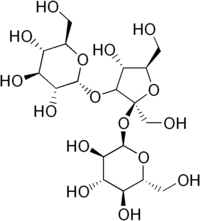Melezitosis
| Structural formula | |||||||||||||||||||
|---|---|---|---|---|---|---|---|---|---|---|---|---|---|---|---|---|---|---|---|

|
|||||||||||||||||||
| General | |||||||||||||||||||
| Surname | Melezitosis | ||||||||||||||||||
| other names |
|
||||||||||||||||||
| Molecular formula |
|
||||||||||||||||||
| External identifiers / databases | |||||||||||||||||||
|
|||||||||||||||||||
| properties | |||||||||||||||||||
| Molar mass | |||||||||||||||||||
| Physical state |
firmly |
||||||||||||||||||
| Melting point |
154-160 ° C |
||||||||||||||||||
| solubility |
soluble in water (50 g l −1 ) |
||||||||||||||||||
| safety instructions | |||||||||||||||||||
|
|||||||||||||||||||
| As far as possible and customary, SI units are used. Unless otherwise noted, the data given apply to standard conditions . | |||||||||||||||||||
Melezitose is a type of sugar that occurs, for example, in honeydew , a sugar-containing excretion product of various Schnabelkerfe (Hemiptera), to which the aphids (Aphidina) belong. These insects synthesize sugar from sucrose and glucose , thereby losing less water through osmosis and at the same time attracting ants as protectors.
Like all types of sugar, melezitose is a carbohydrate and, more precisely, a trisaccharide (triple sugar ) made up of two molecules of glucose and one molecule of fructose . It hydrolyzes under mild conditions to glucose and turanose , an isomer of sucrose.
history
Bonastre first found melezitose in an extract from the larch in 1833 . The name was derived from the French word "mélèze" for larch. The sugar was later found in other plants and in 1917 in honey.
Analytics
The reliable qualitative and quantitative determination of melezitosis in various test materials requires adequate sample preparation . By producing the trimethylsilyl derivatives , the use of the coupling of gas chromatography and mass spectrometry is possible. The coupling of liquid chromatography with mass spectrometry can also be used to analyze the trisaccharides. For special questions, TMS oxime derivatives can also be used for chromatography.
Melezitose in honey
Forest honey from beekeeping , which the bees have obtained from honeydew, sometimes contains a lot of melezitose. Exceeds the concentration of about 10%, so this can honey, as a so-called Melezitose- or cement honey, already in the honey chamber of the bee colony from the bottom of the honeycomb cell forth crystallize . Then it cannot be ejected or can only be ejected with difficulty. Such a high melezitose content in the honey of a hibernating colony can also be associated with severe population losses.
Individual evidence
- ↑ a b c d data sheet D - (+) - Melezitose monohydrate, for microbiology, ≥99.0% from Sigma-Aldrich , accessed on December 26, 2019 ( PDF ).
- ↑ Klaus H. Hoffmann, Melanie Fischer, Wolfgang Völkl, Matthias W. Lorenz: From lice and ants. In: research. 2/2003 , p. 15.
- ↑ M. Bonastre: J. In: Pharm. 19, 443, 1833, p. 626.
- ↑ MI Perlné, K. Horváth, Z. Katona: The possibilities of GC / MS and HPLC in the analysis of sugars and acids in natural matrices. In: Acta Pharm Hung. 70 (3-6), Jul-Dec 2000, pp. 231-238. Hungarian. PMID 11379030
- ↑ EC Wan, JZ Yu: Determination of sugar compounds in atmospheric aerosols by liquid chromatography combined with positive electrospray ionization mass spectrometry. In: J Chromatogr A. 1107 (1-2), Feb 24, 2006, pp. 175-181. PMID 16405980
- ↑ Z. Füzfai, I. Boldizsár, I. Molnár-Perl: Characteristic fragmentation patterns of the trimethylsilyl and trimethylsilyl-oxime derivatives of various saccharides as obtained by gas chromatography coupled to ion-trap mass spectrometry. In: J Chromatogr A. 1177 (1), Jan 4, 2008, pp. 183-189. PMID 18061601
- ↑ Cement honey in the honey and brood chamber - what then? In: ( Page no longer available , search in web archives: Melezitose and Spättracht. )

